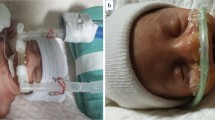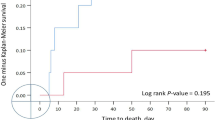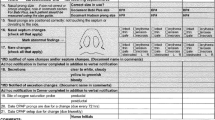Abstract
Objective:
To compare the effectiveness of Fisher and Paykel (FP) and Vapotherm (VT) high-flow nasal cannula (HFNC) in preventing reintubation either within 72 h or <7 days after extubation of premature infants. The primary outcome was the rate of extubation failure defined as reintubation within 72 h. Secondary outcomes included reintubation after ⩽7 days.
Study Design:
This was a prospective, randomized pilot study comparing the extubation success of 40 infants born between 26 and 29 weeks of gestation.
Result:
The rate of extubation failure at 72 h was 18% for FP and 9% for VT. The failure rate ⩽7 days after extubation was 30% for FP and 27% for VT. None of these differences were statistically significant.
Conclusion:
There was no difference between FP and VT in the extubation success of infants born between 26 and 29 weeks.
This is a preview of subscription content, access via your institution
Access options
Subscribe to this journal
Receive 12 print issues and online access
$259.00 per year
only $21.58 per issue
Buy this article
- Purchase on Springer Link
- Instant access to full article PDF
Prices may be subject to local taxes which are calculated during checkout
Similar content being viewed by others
References
Kopelman A, Holbert D . Use of oxygen cannulas in extremely low birthweight infants is associated with mucosal trauma and bleeding, and possibly with coagulase-negative staphylococcal sepsis. J Perinatol 2003; 23 (2): 94–97.
Waugh J, Granger W . An evaluation of 2 new devices for nasal high-flow gas therapy. Respir Care 2004; 49 (8): 902–906.
de Klerk A . Humidified high-flow nasal cannula: is it the new and improved CPAP? Adv Neonatal Care 2008; 8 (2): 98–106.
Shoemaker M, Pierce M, Yoder B, DiGeronimo R . High flow nasal cannula versus nasal CPAP for neonatal respiratory disease: a retrospective study. J Perinatol 2007; 27 (2): 85–91.
Holleman-Duray D, Kaupie D, Weiss M . Heated humidified high-flow nasal cannula: use and a neonatal early extubation protocol. J Perinatol 2007; 27 (12): 776–781.
Saslow J, Aghai Z, Nakhla T, Hart J, Lawrysh R, Stahl G et al. Work of breathing using high-flow nasal cannula in preterm infants. J Perinatol 2006; 26 (8): 476–480.
Hines W . Director, North America, Vapotherm. Personal communication by phone and e-mail; September 2009.
Cornell R . Clinical Projects Manager, Fisher & Paykel Healthcare. Personal communication by e-mail; September 2009.
Spence K, Murphy D, Kilian C, McGonigle R, Kilani R . High-flow nasal cannula as a device to provide continuous positive airway pressure in infants. J Perinatol 2007; 27 (12): 772–775.
Sreenan C, Lemke R, Hudson-Mason A, Osiovich H . High-flow nasal cannulae in the management of apnea of prematurity: a comparison with conventional nasal continuous positive airway pressure. Pediatrics 2001; 107 (5): 1081–1083.
Davies M, Dunster K, Cartwright D . Inspired gas temperature in ventilated neonates. Pediatr Pulmonol 2004; 38 (1): 50–54.
Miller T . High flow therapy and humidification: a summary of mechanisms of action, technology and research. Vapotherm Inc. Documents: Stevensville, MD, 2008.
Dimitriou G, Greenough A . Computer assisted analysis of the chest radiograph lung area and prediction of failure of extubation from mechanical ventilation in preterm neonates. Br J Radiol 2000; 73 (866): 156–159.
Gillespie L, White S, Sinha S, Donn S . Usefulness of the minute ventilation test in predicting successful extubation in newborn infants: a randomized controlled trial. J Perinatol 2003; 23 (3): 205–207.
Kavvadia V, Greenough A, Dimitriou G . Prediction of extubation failure in preterm neonates. Eur J Pediatr 2000; 159 (4): 227–231.
Mueller M, Wagner C, Annibale D, Hulsey T, Knapp R, Almeida J . Predicting extubation outcome in preterm newborns: a comparison of neural networks with clinical expertise and statistical modeling. Pediatr Res 2004; 56 (1): 11–18.
Gupta S, Sinha S, Tin W, Donn S . A randomized controlled trial of post-extubation bubble continuous positive airway pressure versus Infant Flow Driver continuous positive airway pressure in preterm infants with respiratory distress syndrome. J Pediatr 2009; 154 (5): 645–650.
Woodhead D, Lambert D, Clark J, Christensen R . Comparing two methods of delivering high-flow gas therapy by nasal cannula following endotracheal extubation: a prospective, randomized, masked, crossover trial. J Perinatol 2006; 26 (8): 481–485.
Acknowledgements
We acknowledge Fisher & Paykel Healthcare and Vapotherm for funding this study. We also wish to thank the Crouse Hospital NICU nurses, respiratory therapists and staff for supporting this study. Special thanks to Lisa Smith, PNP, for her work as a research nurse.
Author information
Authors and Affiliations
Corresponding author
Ethics declarations
Competing interests
Fisher & Paykel Healthcare and Vapotherm jointly funded this study. We have not received a salary or other personal benefits, and do not hold stock in either company. The study was designed, conducted and analyzed separately from Fisher & Paykel Healthcare and Vapotherm.
Rights and permissions
About this article
Cite this article
Miller, S., Dowd, S. High-flow nasal cannula and extubation success in the premature infant: a comparison of two modalities. J Perinatol 30, 805–808 (2010). https://doi.org/10.1038/jp.2010.38
Received:
Revised:
Accepted:
Published:
Issue Date:
DOI: https://doi.org/10.1038/jp.2010.38
Keywords
This article is cited by
-
Nasal high flow treatment in preterm infants
Maternal Health, Neonatology and Perinatology (2017)
-
Work of breathing indices in infants with respiratory insufficiency receiving high-flow nasal cannula and nasal continuous positive airway pressure
Journal of Perinatology (2014)
-
Use of high flow nasal cannula in critically ill infants, children, and adults: a critical review of the literature
Intensive Care Medicine (2013)
-
CPAP review
European Journal of Pediatrics (2012)



